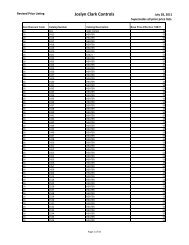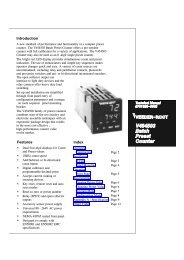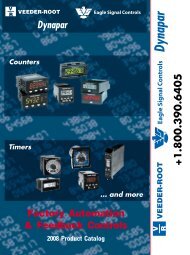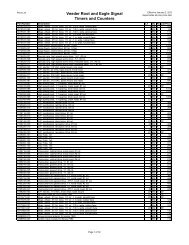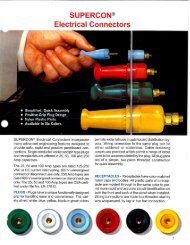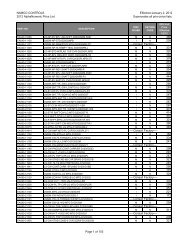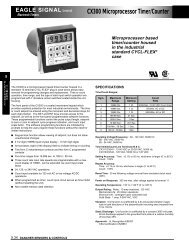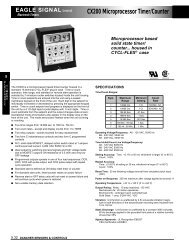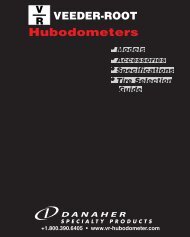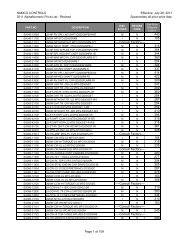S428A Manual - Danaher Specialty Products
S428A Manual - Danaher Specialty Products
S428A Manual - Danaher Specialty Products
You also want an ePaper? Increase the reach of your titles
YUMPU automatically turns print PDFs into web optimized ePapers that Google loves.
DYNAPAR brand PRODUCT MANUAL: Series <strong>S428A</strong> 1/8 DIN Process IndicatorASCII CommunicationsThis is a simple ASCII protocol that providesbackwards compatibility with previousgenerations of products. ASCII is not availablein all models in the range. The Modbusprotocol is recommended for future use.Refer to the relevant Model Group Sectionfor the ASCII and Modbus Application Layer(parameter address/ident information).Physical LayerThe Base address, bit rate and characterformat are configured via the front panel inConfiguration Mode or by using the PCConfigurator software.Physical layer configuration settings possibleare:Data rate: 1200, 2400, 4800(default), 9600 and 19,200 bpsParity: EvenCharacter format: 7 bits percharacter. + 1 stop bit.The transmitter must not start transmissionuntil 3 character times have elapsed sincereception of the last character in a message,and must release the transmissionline within 3 character times of the lastcharacter in a message.Note: Three character times = 1.5ms at19200, 3ms at 9600, 6ms at 4800, 12msat 2400 and 24ms at 1200 bps.Device AddressingThe instrument is assigned a device addressby the user using the 5DD9 parameterin Configuration Mode. The addressmay be set to any unique value from 1(default) to 99. This address is used torecognize ASCII messages intended for thisinstrument. The instrument does not respondto messages that do not match theaddress that has been assigned to it.Session LayerThe ASCII protocol assumes half duplexcommunications. The master device initiatesall communication. The master sendsa command or query to the addressed slaveinstrument and the slave replies with anacknowledgement of the command or thereply to the query.Messages from the master device may beone of five types:Type 1: {S}{N}??*Type 2: {S}{N}{P}{C}* or R{N}{P}{C}*Type 3: {S}{N}{P}#{DATA}* orR{N}{P}#{DATA}*Type 4: {S}{N}{P}I* or R{N}{P}I*Type 5: {S} {N} \ P S S ? *All characters are in ASCII code. See thefollowing Parameter Key table for details ofthe parameters in brackets { }.{S}is the Start of Message character L (Hex 4C) or R (Hex 52). L is used for Controllers; R is used for Profilers.{N} is the slave device address (in the range 1 - 99); addresses 1 - 9 may be represented by a singledigit (e.g. 7) or in two-digit form, the first digit being zero (e.g. 07).{P } is a character which identifies the parameter to be interrogated/modified.{C} is the command (Refer to the Serial Communications Application Layer information for each Model Group)# indicates that {DATA} is to follow (Hex 23){DATA} is a string of numerical data in ASCII code (refer to the Data Element table below)P is the Program NumberS S is the Segment Number (01 to 16)* is the End of Message Character (Hex 2A)No space characters are permitted in messages. Any syntax errors in a received messagewill cause the slave instrument to issue no reply and await the Start of Message character.4.10<strong>Manual</strong> Number: 702683-0001 Rev.: A May, 2006 Serial Communications




